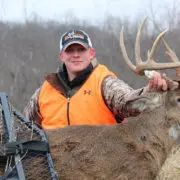Post Rut Whitetails | Switching Up Stand Locations
Post Rut Deer Hunting | Stand Locations
No question the rut is an exciting time to be in the deer stand. There is not a better time to put a big mature whitetail on the ground than during the months of late October and early November. Although many whitetail hunters will experience the thrill of punching tag on a November whitetail, the rut is anything but a guarantee. So what do you do when things don’t play out the way you had hoped, and you find yourself staring the end of the rut directly in the face? The answer is simple; you gear up for post rut whitetails!
There are those who say that whitetail hunting simply doesn’t get any better than during sweet November, however, there are a growing number of whitetail hunters that are beginning to see the advantages of hunting mature whitetail bucks during the post-rut, and on into the late season. Many appreciate the new set of challenges that come with hunting and harvesting a post-rut whitetail buck, while others really enjoy hunting whitetail deer during the frigid, late season cold when there is a several inches of fresh white snow on the ground. One thing is for certain, hunting post rut and/or late season whitetail deer is certainly different than chasing them during the rut.
So What’s the Difference?
One of the most exciting aspects of hunting a mature whitetail buck is simply seeing how their patterns and focus change over the course of the fall. From the early season where bucks can sometimes tend to still be in their bachelor groups, keying in on early season forages all the way through the rut and into the post rut. For many that are what makes whitetail deer so exciting to chase, you have to stay abreast of what the deer are doing and adjust your hunting strategies accordingly.
So, to effectively hunt and harvest a post-rut whitetail buck you need to first understand what is going on in the world of the deer during this time. First and foremost, it is important to keep in mind that the process of going through the rut is very hard on both bucks and does (albeit a little harder on the buck) and both handle the adversity in a little different way, moving into the post rut. During the post rut, does tend to become solitary, though sometimes last year’s fawn will still be close by, by the time the rut rolls around they have generally run last year fawns off and are solely focused on breeding. Once bred, the doe will begin to build up her body as best she can in preparation for the winter and to ensure that she is in optimal condition comes spring.
Bucks, on the other hand, will continue to roam the countryside in search of the last remaining doe in estrous that they can find. Occasionally, does that come into estrous late can sometimes spark what has become known as the “second rut”. This can be an excellent time to catch a big mature buck on his feet, cruising for does even long after the end of the official rut. Opportunities like the “second rut” can sometimes come and go quickly, so it is important to keep running your trail cameras throughout the rut and on into the postseason. This information can give you some insight as to whether you have a hot doe in the area, which can help you determine if you current stand locations are still appropriate or if you need to begin making the change into a post rut/late season hunting strategy.
Second rut aside, during the post-rut whitetail bucks are simply worn down. They have spent the last four weeks or so roaming the countryside in search of does. They have expended a vast amount of energy on rutting, fighting, and breeding with very little time spent on resting and foraging. As the rut ends and the post-rut begins, the buck will still show some interest in sparring and fighting. Calling techniques such as light rattle and some grunting can still be effective, though you want to be sure to keep in light and infrequent. As the post rut transition, whitetail deer, and especially bucks will begin to focus on rebuilding their body reserves that have been depleted during the rut. As a result, hunting food sources can be absolutely stellar during the post rut and on into the late season.
Post Rut Stand Locations
There varying opinions on post rut stand locations, however; there are two areas that have proven to be very effective for putting post rut bucks on the ground year after year after year. So if you are planning to hit the woods in search of a post rut buck, here are some areas that you may consider moving your Big Game tree stands to.
Major Trails, Close to Bedding Areas
When you are talking about a post rut buck, you are talking about an animal that is not going to have a whole lot of energy to spare. As a matter of fact, a post rut buck is going to look for every opportunity they can to find a secure bedding area that is typically close to a food source such a grain fields or turnip plot. If you think about it, it only makes sense that in order for a deer to build up a severely depleted reserve of protein and carbohydrates, they would try to be a close as they can safely be to the food source, in order to limit the amount of energy burned in travel from bedding to food.
Though post rut bucks will tend to be very reclusive, they typically will not be too sneaky in terms of using secondary trials to get from point A to point B. They will choose the path of least resistance in order to conserve energy and rebuild their reserves. One of the best stand locations that you can have to try to hunt and harvest a post-rut whitetail is along a major trail that is very close to cover or bedding. These sets can produce excellent results, especially later during the post rut as the weather begins to deteriorate. These sets, while productive do come with their set of challenges namely the entry and exit for the hunter. Often, for these sets to be successful the hunter will need to get as close as possible to the buck bedding area. This can often prove to be very difficult so ensuring that you have effective entry and exit route that you can use relatively noise free is critical. Likewise, only entering these areas with the proper wind is key to success. Once you bump a post rut buck, it can sometimes be difficult to locate them again.
Food, Food, and More Food
You have probably sensed that this topic was coming throughout the majority of this article, but the importance of high energy foods to a post-rut whitetail cannot be overstated. It is something that they absolutely need for survival and is something that they will actively be seeking out once the rut has come to an end.
While the end of the rut will drive whitetails to seek out nutritious forages like corn and soybeans as well as turnips and radishes, the harsh weather conditions of the late season can also drive these deer to key in on these late season food sources.
Hunting food plots or grain fields are excellent options for post rut whitetails, both with archery and firearm equipment. If you are hunting the wide open expanses of a grain field, where you can see for a great distance, a tower blind or tripod stand can be just what the doctor ordered. These stands can keep you comfortable and concealed while giving you the ability to see and shoot from a great distance.
If you are planning to take after a post-rut whitetail with archery equipment or you just want to get up close and personal, then a solid hang-on or ladder stand placed close to the main trail into or out of the food plot can be deadly on post rut whitetails.
The number one take home point is that it is important to remember is that a deer’s behavior changes throughout the year. You cannot expect to be successful hunting the same stand that you hunt during the early part of the year during the post rut. Sure, we all have those go-to spots that produce year after year regardless of the time of year it is, but the need to constantly move your stand locations based on the time of year can often be the missing factor for many hunters, and being reluctant to do so can often result in eat tag soup rather than backstrap. If you hit the woods in pursuit of post rut whitetails, keep these stand locations in mind and with a little luck, you will punch a tag on a late season bruiser.


